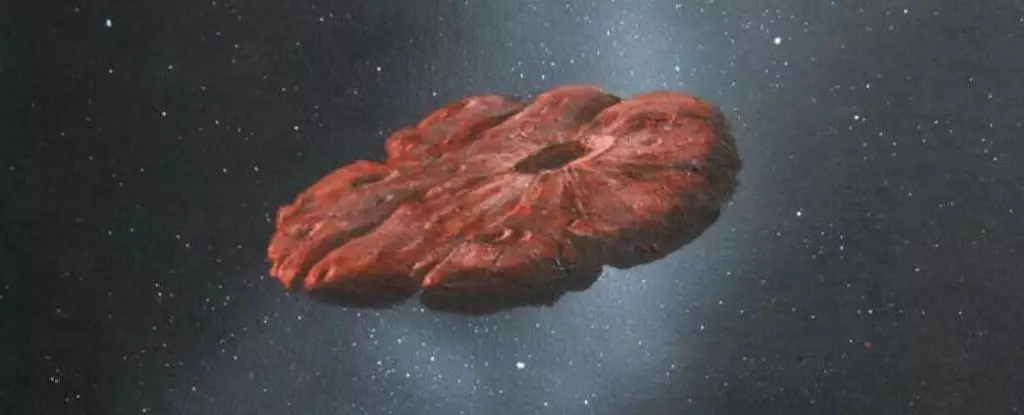In 2017, a stunning event unfolded in our cosmic neighborhood when a strange object, named ‘Oumuamua, zipped through our Solar System with an astonishing velocity. This was not just another space rock; it was the first confirmed interstellar object (ISO) ever observed passing through our Solar System, and its elongated shape, approximately a quarter of a mile long, sparked intrigue across the scientific community. ‘Oumuamua, which translates to “scout” in Hawaiian, acted as a harbinger of the universe’s mysteries, compelling astronomers to harness the most advanced telescopes in an attempt to understand its origins and implications.
What fascinated researchers even more was the recognition that these ISOs orbit stars before being expelled into the void of space. Their journeys often originate from tumultuous landscapes—be it from massive collisions or other cosmic calamities. It is theorized that ‘Oumuamua had been traversing the Milky Way for hundreds of millions of years, a testament to the vast and breathtaking scale of both time and space. Two years after this intriguing first encounter, a second ISO, named Comet Borisov, was identified by an amateur astronomer, adding another layer to the puzzle of cosmic visitors.
The Challenges of Detection and Observation
Despite the potential wealth of knowledge ISOs could offer, the reality is that most of these celestial wanderers go undetected. It is estimated that there are over 10 septillion ISOs drifting throughout the Milky Way; however, our capabilities in monitoring their trajectories remain limited. Often, these fast-moving entities elude our noticing until they have already sped past Earth. This leads to a profound question: how can we enhance our observational techniques to better predict and intercept these cosmic nomads?
Conventional ground-based and space telescopes struggle to keep pace with the fleeting nature of ISOs, and improving detection methods is imperative. The speed at which these objects travel makes them prime candidates for missed opportunities in astronomical research. While catching up with an ISO may seem daunting, innovative approaches, such as leveraging gravitational slingshots, could potentially redirect spacecraft to their paths, albeit with a significant investment of time and resources.
Harnessing Cutting-Edge Technologies
To truly unlock the mysteries of interstellar visitors, we need to develop pioneering strategies that go beyond mere observation. Exciting projects like NASA’s Bridge and the European Space Agency’s Comet Interceptor are paving the way for dynamic missions targeting these cosmic wanderers. Bridge aims to launch quickly upon detection of an ISO, while Comet Interceptor is designed to lie in wait, ready for an ambush of either a long-period comet or an ISO, minimizing time lost after detection.
While these missions are promising, they face a frustrating limitation: speed. Recent analyses have illuminated the possibility of intercepting objects like ‘Oumuamua, but accomplishing this will require forward-thinking technologies, particularly in artificial intelligence (AI), which can augment decision-making processes for real-time responses to incoming ISOs. Our future spacecraft may need to operate in swarms, allowing them to image targets from multiple perspectives and adapt mid-flight using networked intelligence.
Innovative Propulsion and Materials
The path to engaging with ISOs also involves advancing propulsion technologies. Solar sails, which utilize sunlight to propel spacecraft, are already being leveraged. Future iterations of these crafts might even integrate laser propulsion to achieve unprecedented speeds without the need for bulky fuel tanks. This kind of innovation could transform our capacity to approach fast-moving objects and turn them into subjects of extensive study.
However, speed alone isn’t the only consideration for mission success. Spacecraft venturing close to ISOs must be engineered to withstand intense heat and potential erosion from the dust that might burst forth from these objects. Researchers are delving into advanced materials like carbon fibers, even exploring the concept of 3D printing structures that offer both durability and light weight.
Furthermore, some ideas resonate with using existing materials in innovative ways, examining how traditional options like cork or ceramics might offer effective solutions to challenges in space engineering.
The Future Awaits
The realm of ISOs unveils a fascinating frontier that beckons us to explore beyond what is immediately observable. While many challenges lay ahead, the advancement of emergent technologies and innovative scientific thinking positions us well to engage profoundly with the cosmos. With projects like the Vera C. Rubin Observatory set to begin its ten-year survey of the night sky, we may very well be on the brink of an observational revolution that brings to light countless ISOs and enables possible missions to chase these extraordinary travelers.
Harnessing the cosmos requires collaboration between ground-based and space-based systems, augmenting our methods with artificial intelligence to stay ahead of these transient phenomena. However, potential cuts to space science funding threaten to curtail this progress. We must champion the imperative to invest in astronomical research and exploration to ensure that we don’t miss out on invaluable scientific opportunities that lie just beyond our celestial doorstep. The journey toward discovering our universe’s secrets continues, and with every new ISO detected, a door opens to understanding the vastness beyond our Solar System.


Leave a Reply